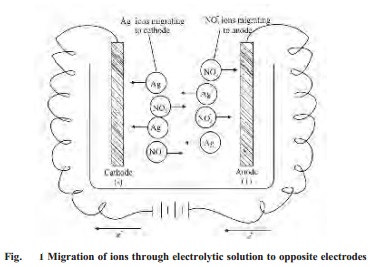Chapter: 11th 12th std standard Class Organic Inorganic Physical Chemistry Higher secondary school College Notes
Postulates of Arrhenius Theory
Postulates
of Arrhenius Theory :
1. When dissolved in water, neutral electrolyte molecules are split up into two types of charged
particles.
These particles were called ions and the process was termed ionisation. The positively charged
particles were called cations and
those having negative charge were called anions.
The theory assumes that the ions are already
present in the solid electrolyte and these are held together by electrostatic
force. When placed in water, these neutral molecules dissociate to form separate anions and cations.
A+ B- -- -- > A+ + B-
For that reason, this theory may be referred to
as the theory of electrolytic dissociations.
2. The ions present in solution constantly
reunite to form neutral molecules. Thus there is a state of equilibrium between
the undissociated molecules and the ions.
AB < -- --- > A+ + B-
Applying the Law of Mass Action to the ionic
equilibrium we have,
[ A + ][ B - ] / [AB] = K
where K is called the Dissociation constant.
3.The charged ions are free to move through the
solution to the oppositely charged electrode. This is called as migration of
ions. This movement of the ions constitutes the electric current through
electrolytes. This explains the conductivity of electrolytes as well as the
phenomenon of electrolysis.
4.The electrical conductivity of an electrolyte
solution depends on the number of ions present in solution. Thus the degree of
dissociation of an electrolyte determines whether it is a strong electrolyte or
a weak electrolyte.
We know that electrolytes dissociate in
solution to form positive ions (cations) and negative ions (anions).
AgNO3 -- -- -
> Ag+ + NO3-
CuSO -- -- -
> Cu2+ + SO 2-
H2SO-- -- - > 2H+ + SO 2-
As the current is passed between the electrode
of the electrolytic cell, the ions migrate to the opposite electrodes. Thus in
the electrolytic solution of AgNO3, the cations (Ag+)
will move to the cathode and anions (NO3- ) will move to
the anode. Usually different ions move with different rates. The migration of
ions through the electrolytic solution can be demonstrated by the following
experiments.

5.The
properties of solution of electrolytes are the properties of ions. The solution
of electrolyte as a whole is electrically neutral unless an electric
field is applied to the electrodes dipped into
it. Presence of hydrogen ions (H+) renders the solution acidic while
presence of hydroxide ions (OH- ) renders the solution basic.
6.There are two types of electrolytes. Strong electrolytes
are those when dissolved in water are completely dissociated (ionised) into
ions of positive and negative charges.
The total number of cations and anions produced are equal to those in the
formula of the electrolyte.
Al2(SO4)3 --
> 2Al3+ + 3SO 2-
NaCl,
KCl, AgNO3 etc., are few examples of strong electrolytes.
In the case of weak electrolytes, there is
partial dissociation into ions in water and an equilibrium exists between the
dissociated ions and the undissociated electrolyte.
(e.g.,) CH3COOH < -- --- > CH3COO- + H+. Acetic acid is a weak
electrolyte in water and unionised acetic acid
molecules are in equilibrium with the acetate anions and H+ ions in
solution.
Related Topics